Case Report of Youngest Successful Bilateral Cartilage Tympanoplasty in India
Gaurav Ashish1, Ankita Gupta2
1 Consultant, Department of ENT, Vellore ENT Centre, Patna, Bihar, India.
2 Audiologist, Department of ENT, Vellore ENT Centre, Patna, Bihar, India.
NAME, ADDRESS, E-MAIL ID OF THE CORRESPONDING AUTHOR: Dr. Gaurav Ashish, 3, BSIDC Colony, Dr Rameshwar Dayal Path, SK Puri, Patna-800013, Bihar, India.
E-mail: gauravashish05@gmail.com
Paediatric Chronic Suppurative Otitis Media (CSOM) remains a challenge for the treating otologists. Usually, concurrent foci of infection lie in the oropharynx or nasopharynx and treating these eventually leads to resolution of ear discharge. However, refractory cases can be threatening in view of complications secondary to CSOM.
A two year and 10-month-old child presented with recurrent profuse mucopurulent ear discharge which had been refractory to multiple medical treatment. Recently she had recurrent otitis external episodes with excoriations of canal skin. Child underwent bilateral tympanoplasty with cartilage palisading technique. At eight months follow-up, the neotympanum is intact and the child had no further episodes of ear discharge.
This case to our knowledge is the youngest child to undergo a bilateral successful cartilage tympanoplasty in Indian subcontinent. This case report is written with the aim to highlight the fact that cartilage tympanoplasty can be considered in treating refractory cases of paediatric CSOM.
Chronic suppurative otitis media, Neotympanum, Pseudomonas aeruginosa
Case Report
A two year and 10-month-old girl was brought to the outpatient department with history of recurrent bilateral ear discharge for the last one year. The child was previously treated elsewhere with multiple systemic and topical antibiotics, however, the ear discharge had not settled. The discharge was mucoplurulent, non-foul smelling, and non blood tinged and profuse in quantity.
Multiple culture and sensitivity tests of the ear discharge were done earlier and subsequently antibiotics were also administered, but the discharge had neither decreased in quantity nor in the frequency. Endoscopic and clinical examination of nose, nasopharynx and oropharynx were non contributory. Otoendoscopy revealed bilateral large central perforation [Table/Fig-1,2]. Visual reinforcement audiometry was suggestive of bilateral mild conductive hearing loss.
Right pre-operative otoendoscopy picture.
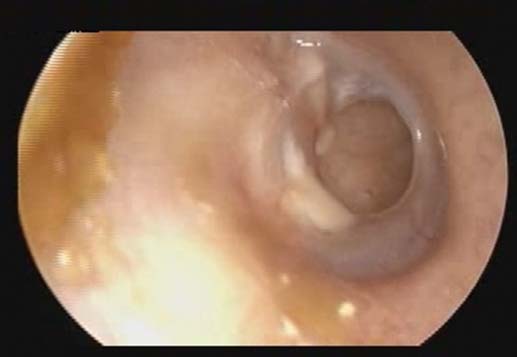
Left pre-operative otoendoscopy picture.
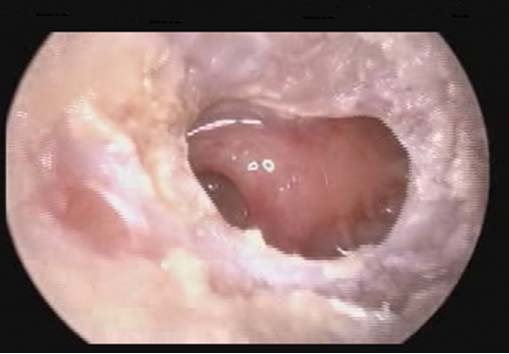
The child had been irritable for the last two months and was having poor appetite. Reccurent ear discharge was causing repeated episodes of otitis externa and excoriation of the skin in external auditory canal. In the above context, it was decided to perform bilateral tympanoplasty. Postaural approach was adopted and temporalis fascia was harvested along with conchal cartilage. Thorough dilute betadine irrigation was given to the middle ear. Ossicles were intact and mobile. Conchal cartilage was placed in mesotympanum via palisade technique. Wound was closed in layer and bilateral mastoid dressing was applied [Table/Fig-3]. At eight months post op follow-up, the neotympanum was intact [Table/Fig-4,5] with no further episodes of ear discharge. Repeat audiometric analysis suggested bilateral normal hearing.
Bilateral post-operative mastoid dressing.
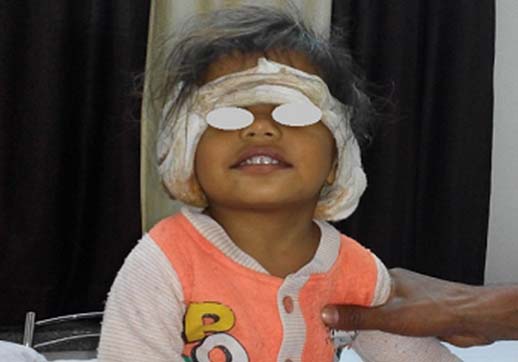
Right postoperative otoendoscopy picture.
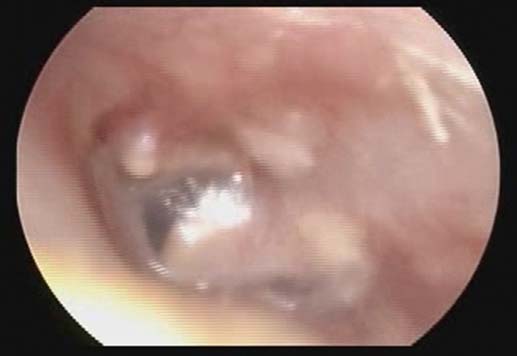
Left postoperative otoendoscopy picture.
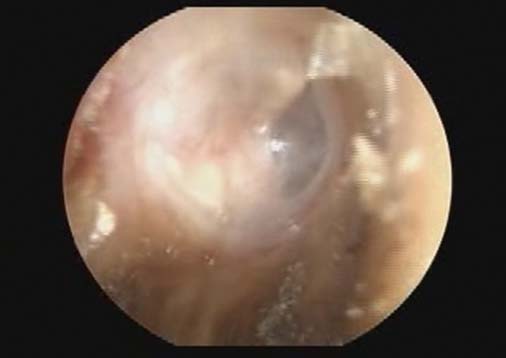
Discussion
The credit for first tympanoplasty dates back to 1640 by Marcus Banzer who had used pig’s bladder as lateral graft material [1]. Zoellner and Wullstein in 1952 had more elaborately described the various types of tympanoplasty using various graft materials [2]. But it was Prof Mirko Tos who ultimately illustrated the technique of cartilage tympanoplasty [3].
Paediatric Chronic Suppurative Otitis Media (CSOM) in paediatric population remains one of the most common chronic childhood infections in the world [4]. CSOM is also the most important cause of conductive or sensorineural hearing loss. Cases of paediatric CSOM has been primarily treated by topical antibiotic ear drops and routine aural toileting which can reduce the infection load significantly [4]. As the most common causative organism remains Pseudomonas aeruginosa followed by aerobic bacteria, the quinolones are better than non quinolones as ear drops. Systemic antibiotics have been by far not advised for treating cases of CSOM except in refractory cases. Poor mucosal vascularity in chronically discharging ears lead to poor antibiotic concentration [4].
Refractory cases of CSOM in children can be surgically managed by tympanoplasty. The age at which a child can be operated for tympanoplasty remains a controversy. The age remains a potential prognostic indicator deciding the outcome of the procedure as per some authors. However, as per Freidman et al., who studied the outcome of tympanoplasty in 119 children observed that the age was not a factor influencing the surgical outcomes in terms of graft uptake and audiological gain [5,6].
Surgical management of CSOM in paediatric age group is a controversial and challenging entity for most of the otorhinolaryngologists. Lower success rate, chances of spontaneous closure and lack of eustachian tube maturity are some of the factors proposed against surgical management by some of the authors [7].
Success has been assessed in various ways in terms of strength of graft membrane, healed tympanic membrane, lack of retraction and in terms of audiological gain by various authors. The success rates in cases of paediatric tympanoplasty have been enlisted between 35% to 94% [8]. Proposed prognostic indicators for successful outcome of the paediatric tympanoplasty have been suggested as size and location of perforation, ottorhea, eustachian tube function, status of middle ear and age of the child [7].
The most debated prognostic factor has been the age of the child. However, many studies have ruled out any statistically significant role of age in deciding the outcome [8,9]. The surgical outcomes have been better in dry ears and also depend on the surgical technique and graft material used.
The results have been better with use of temporalis fascia in paediatric tympanoplasty with success rate as high as 85.7% as per Riberio et al., [10]. As per Ozbek et al., the success rate have been better in cases of temporalis facia graft along with palisade cartilage technique [11]. It has also been well established that there exists no difference in the audiological outcome between those grafted with temporalis fascia and those with cartilage [12]. There is no minimum age as described in literature below which a perforation should not be closed surgically [10].
Paediatric cases of CSOM should be treated surgically only when maximal medical therapy has failed. However surgical option shouldn’t be delayed in view of impending complications, which can be as simple as hearing loss. The judgement between surgical and continuing medical therapy has to be very meticulous.
It does not mean that every paediatric case of CSOM should be managed surgically. Primary treatment still remains the use of topical antibiotic with regular aural toileting. Poor mucosal vascularity in chronically discharging ears and lower antibiotic concentration limit the role of systemic antibiotics [4].
However, prolonged recurrent episodes of ear discharge can lead to various complications. Hearing loss, either conductive or sensorineural, is one of the most common complications of recurrent ear discharge which can adversely affect the intellectual outcome of the child. Hence, it is of utmost importance to meticulously decide to switch over to surgical management before complications occur in cases of paediatric CSOM [8].
To our knowledge this is the youngest child (2 year 10 months) in Indian subcontinent to undergo a successful bilateral cartilage tympanoplasty with an eight months follow-up. The other youngest case, outside India, we could find was 2.9 year old published by Carr et al., [9]. This case report also enlightens the fact that cartilage tympanoplasty can successfully treat refractory cases of paediatric CSOM.
Conclusion
The first line of management in paediatric CSOM remains use of topical ear drops and removal of any concurrent infection in nasopharynx or oropharynx. However, in refractory cases where all modes of medical therapy have failed and chances of complications are evident, we should not wait and switch over to surgical management. The above case is presented aiming at developing insights towards successful surgical management of refractory cases of paediatric CSOM.
Contribution of authors
Gaurav Ashish:-Concept, research, intellectual input
Ankita Gupta:-Editing, intellectual input
[1]. Al Qahtani B, Al Tuwaijri M, Al Tamimi F, Al Majed A, Wasi M, Al Jabber A, Tympanometric patterns in patients undergoing cartilage tympanoplasty of 0.6 mm thicknessIndian J Otol 2015 21(4):233 [Google Scholar]
[2]. Wullstein HL, Wullstein SR, The problem of the hidden primary cholesteatoma in tympanoplastyArch Otolaryngol Chic Ill 1960 1973 97(2):194-97. [Google Scholar]
[3]. Tos M, Cartilage tympanoplasty methods: proposal of a classificationOtolaryngol—Head Neck Surg Off J Am Acad Otolaryngol-Head Neck Surg 2008 139(6):747-58. [Google Scholar]
[4]. Sandhu N, Thomson D, Stang A, In children with chronic suppurative otitis media, should one prescribe topical or systemic antibiotics?Paediatr Child Health 2012 17(7):385-86. [Google Scholar]
[5]. Nevoux J, Roger G, Chauvin P, Denoyelle F, Garabédian EN, Cartilage shield tympanoplasty in children: review of 268 consecutive casesArch Otolaryngol Head Neck Surg 2011 137(1):24-29. [Google Scholar]
[6]. Friedman AB, Gluth MB, Moore PC, Dornhoffer JL, Outcomes of Cartilage Tympanoplasty in the Pediatric PopulationOtolaryngol—Head Neck Surg Off J Am Acad Otolaryngol-Head Neck Surg 2013 148(2):297-301. [Google Scholar]
[7]. Yılmaz MS, Güven M, Kayabasoglu G, Akidil Ö, Kaymaz R, Anatomic and functional results of cartilage type 1 tympanoplasty in children and the evaluation of the success of surgery with parental perceptionTurk Arch Otolaryngol 2014 52:7-11. [Google Scholar]
[8]. Caylan R, Titiz A, Falcioni M, De Donato G, Russo A, Taibah A, Myringoplasty in children: factors influencing surgical outcomeOtolaryngol—Head Neck Surg Off J Am Acad Otolaryngol-Head Neck Surg 1998 118(5):709-13. [Google Scholar]
[9]. Carr MM, Poje CP, Nagy ML, Pizzuto MP, Brodsky LS, Success rates in paediatric tympanoplastyJ Otolaryngol 2001 30(4):199-202. [Google Scholar]
[10]. Ribeiro JC, Rui C, Natercia S, Jose R, Antonio P, Tympanoplasty in children: A review of 91 casesAuris Nasus Larynx 2011 38(1):21-25. [Google Scholar]
[11]. Ozbek C, Ciftçi O, Tuna EEU, Yazkan O, Ozdem C, A comparison of cartilage palisades and fascia in type 1 tympanoplasty in children: anatomic and functional resultsOtol Neurotol Off Publ Am Otol Soc Am Neurotol Soc Eur Acad Otol Neurotol 2008 29(5):679-83. [Google Scholar]
[12]. Dornhoffer JL, Hearing results with cartilage tympanoplastyThe Laryngoscope 1997 107(8):1094-99. [Google Scholar]